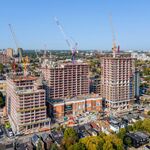I think we are saying the same thing, ie only Flexities from the TTC order can run on TTC trackage given curves and whatnot. So, what forces a change in the spec within the option for 400 more (given it was an option on the TTC order) to make it different from an option on more city-compatible Flexities? Is it too late to convert the option for 196 additional vehicles (182+ 14) to 136 additional Metrolinx spec and 60 additional city spec vehicles?
I don't know. Part of the reasoning behind adding the Flexity Freedom order to the TTC's was that there is some commonality of parts - the basic parts of the control system is a fairly high-value one, for instance. I suspect that the drivetrain is another. HVAC but one more.
But can the orders just be swapped back and forth? I guess it depends on whether the lead time is far enough that Bombardier could go to their suppliers and switch up the components.
That leaves Metrolinx 60 short. Is there still time to change the design of the new lines to allow non-Flexity vehicles on the new lines? Crosstown, for instance, has virtually no curves other than maybe the Mount Dennis yard. Ground hasn't been broken there. Is there an LRT on the books that only needs 60 vehicles - Hurontario? KW? If so, some property may become an oddball but that's better than a single property supporting two types of vehicles.
All of the Metrolinx-built lines are being done so to be able to virtually use any off-the-shelf vehicle. That was the beauty of building them as so - when its time for the next generation of vehicles, there would be nothing preventing them from ordering Siemens, or Alstom, or CAF, or anyone else who happens to exist then.
My basic point is, all concerned should be bending heaven and earth to avoid handing BBD any more business. How that's achieved may require creative thinking by those who understand the nuts and bolts. We should not accept "It cant be done" without challenging in every direction possible.
- Paul
I don't think that's true or fair. They were plenty late with the TR order to start with, and despite all of the initial teething problems that they've had, both in terms of deliveries and operation, they're pretty darn close to be should be for deliveries. Yes, Bombardier is a couple of years late now - but the order was spread out enough that they do have the potential to get it back to be pretty close to fully delivered on schedule. The cars are proving to be quite reliable.
I don't know the answer, and that's why I'm asking. Yes, some of these might conceivably be minor...I'm guessing that the base design for Flexity assumed different users will want different appliances, pantographs being a good example. It may be a matter of unbolt one, bolt on a different one. Same with guage....lift the car off the narrow trucks, drop it on the wider trucks. The design may have the clearance for wider guage designed in. The rear cab? Probably a bigger consideration in terms of wiring, electronics, etc....but TTC doesn't need it, just lock it and don't use it. Strip any obvious reusable components eg the seat. Remember the G-series subway cars with no cabs?
It was helpful to know that one of the differences between Outlooks and Freedoms and such is width. That is certainly a more significant consideration. But again, it may be that the underlying modules can be built to a different width without penalty, provided sufficient notice is given. None of these are on the erecting shop floor yet.
First off, all of the G-cars had cabs - but the G-3 cars had no operating controls. That's probably what you were thinking.
As for the differences between cars, I'm not actually convinced that the trucks are actually different, beyond the spacing between the sideframes. The cars for the Metrolinx network will have different transformers to deal with the different line voltage, and will have a control system that is capable of operating in trains and handling ATO/ATC - both are items that are not necessary for the legacy network.
The biggest issue, however, is the body and articulations. The Flexity Freedom cars are built to one of the common standards for LRT cars used elsewhere in the world, with 25m minimum horizontal curve radius and 2.65m bodies. The cars for the legacy network have narrower bodies - 8'6", and are designed to handle much tighter curve radiuses both vertically and horizontally.
I'm still puzzled by the statement that the wider non-city cars were contracted as an option to the original narrower city cars, so the original tender must have permitted the buyer to specify which model would be procured under the option. Is there any reason why this specification can't be changed again? Again, BBD is clearly early on in procuring the raw materials, and setting up its production lines.
Assuming that Bombardier's lead time is long enough, in theory there shouldn't be a problem. But I don't know what Bombardier's lead time is.
Dan
Toronto, Ont.




